
Container homes have emerged as a versatile and affordable housing solution across Africa, particularly in the East African region. Countries like Uganda, South Sudan, Rwanda, Burundi, the Democratic Republic of Congo (DRC), and Kenya are adopting container architecture to address various housing challenges, from urbanization to affordable housing and disaster relief. In each country, cultural preferences, environmental factors, and economic realities shape the way container homes are designed and utilized. Let’s explore how container homes are making an impact across these East African nations.
Uganda
In Uganda, the growing interest in container homes is being driven by rapid urbanization and a housing deficit in major cities like Kampala. Container houses provide an affordable and quick alternative to traditional construction methods, particularly for young professionals and those seeking more sustainable living options. Many Ugandan container homes are designed to maximize space efficiency, incorporating open floor plans, mezzanine levels, and rooftop terraces.
The country’s warm climate influences the need for passive cooling solutions, such as large windows, cross-ventilation, and shaded outdoor areas. Entrepreneurs are also converting shipping containers into mobile offices, restaurants, and retail spaces, capitalizing on the affordability and mobility of containers. As the housing crisis deepens in urban areas, container homes are becoming a creative and practical way to provide housing while maintaining environmental consciousness.
South Sudan
In South Sudan, container homes have taken on a different role, often serving as temporary shelters for displaced populations affected by conflict and natural disasters. The mobility and durability of shipping containers make them ideal for emergency housing solutions. International organizations and NGOs have introduced container homes to South Sudan as part of relief efforts, providing safe and secure shelter in areas where traditional building materials are scarce or expensive.
These container homes are typically basic, with minimal modifications, but they offer a level of protection and stability that traditional makeshift shelters cannot. Additionally, there are efforts to transition these temporary homes into more permanent settlements by upgrading insulation, adding solar panels for electricity, and improving sanitation facilities. The flexibility of container homes allows them to be relocated and reused as needed, making them a valuable resource in South Sudan’s challenging environment.

Rwanda
Rwanda has been at the forefront of sustainable development in Africa, and container homes are part of this green housing movement. Known for its environmental initiatives, Rwanda sees container homes as a way to promote eco-friendly living while addressing housing shortages in its rapidly growing cities like Kigali. Many Rwandan container homes are built using recycled containers, with an emphasis on energy efficiency through solar power, rainwater harvesting systems, and eco-friendly insulation materials.
The country’s hilly terrain and temperate climate allow for innovative designs that blend container homes with natural landscapes, often incorporating green roofs and outdoor terraces. Architects in Rwanda are also experimenting with modular designs that allow for easy expansion, making container homes suitable for a wide range of residents, from small families to larger communal living spaces. Rwanda’s focus on sustainability and green living has helped container homes gain popularity as a modern and affordable housing option.
Burundi
In Burundi, container homes are slowly gaining traction as an affordable and durable housing solution, particularly in rural areas where access to traditional construction materials can be limited. The affordability of containers makes them appealing to low- and middle-income families, especially as the country continues to recover from years of political instability and economic challenges. Container homes in Burundi are often designed with simple, functional layouts, focusing on practicality rather than luxury.
Due to the country’s warm and tropical climate, many container homes incorporate features like wide verandas and large windows to promote airflow and natural cooling. In some communities, container homes are being used for educational and healthcare facilities, offering a cost-effective way to build durable structures in remote regions. As container architecture gains more recognition, there is potential for these homes to become a more widespread solution to housing shortages in Burundi.
Democratic Republic of Congo (DRC)
In the DRC, container homes are being used to address housing shortages in urban areas like Kinshasa, as well as in mining regions where workers require temporary yet sturdy housing. The ruggedness of shipping containers makes them well-suited for the DRC’s challenging terrain and fluctuating weather conditions. In urban centers, container homes are gaining popularity as affordable alternatives to traditional housing, with developers repurposing shipping containers into compact but functional living spaces.
Many container homes in the DRC are designed with basic amenities, including solar panels for electricity, water tanks, and basic sanitation systems. In mining areas, container homes serve as temporary housing for workers, providing them with safe and weather-resistant shelters. The DRC’s embrace of container homes reflects the country’s need for fast, affordable, and durable housing solutions in the face of economic and environmental challenges.
Kenya
Kenya has emerged as one of the leading countries in Africa for container home innovation, particularly in its bustling capital, Nairobi. The high cost of land and housing in urban areas has driven many Kenyans to seek alternative, affordable housing solutions, and container homes fit the bill. Architects and developers in Kenya are designing stylish, modern container homes that cater to both middle-income buyers and those looking for affordable housing.
Nairobi has seen the rise of container home communities, with clusters of container homes forming eco-friendly neighborhoods that prioritize sustainability and energy efficiency. In addition to residential projects, containers are being used for commercial spaces, including shops, cafes, and offices. Kenya’s entrepreneurial spirit has led to the repurposing of containers for unique applications, such as mobile medical clinics and pop-up markets. The country’s innovative use of container architecture is helping to address the housing shortage while promoting eco-friendly construction practices.

Conclusion
Container homes have become a versatile and innovative solution to housing challenges across East Africa. From urban developments in Kenya to emergency shelters in South Sudan, the adaptability of shipping containers has made them a valuable resource in addressing a wide range of housing needs. Each country has embraced container homes in a unique way, influenced by cultural, economic, and environmental factors. As East Africa continues to grow and develop, container homes will likely play an increasingly important role in providing sustainable, affordable, and resilient housing for the future.
FAQs – Container Houses
Why are container homes popular in East Africa?
Container homes are popular due to their affordability, durability, and flexibility in addressing housing shortages and urbanization challenges.
How do container homes cope with East Africa’s climate?
Container homes in East Africa are designed with features like ventilation, shading, and insulation to adapt to the region’s warm and tropical climates.
Are container homes sustainable?
Yes, container homes promote sustainability by repurposing used shipping containers and incorporating eco-friendly design elements like solar power and rainwater harvesting.
Can container homes be used for commercial purposes?
Absolutely. Container homes in East Africa are used for commercial applications, including offices, shops, cafes, and mobile medical clinics.

Founder & CEO
Mukesh Patel is the Founder & CEO of Build Matt ltd, specializing in Pre-Engineered Buildings (PEB) and general steel fabrication. With advanced technology, modern machinery, and a skilled workforce, he delivers efficient and high-quality solutions across East and Central Africa, including Uganda, Kenya, Tanzania, Congo, South Sudan, Rwanda, and Burundi.
- How Prefab Steel & Modular Buildings Reshape Education and Healthcare?
- How Steel Agricultural Buildings Offer Long-Term Solutions?
- How Industrial Shade Structures Enhance Employee Well-being?
- Prefabricated Cold Storage Safety & Security Features: Minimizing Operational Risks
- Prefabricated Steel Warehouses Building Process: From Concept to Completion
